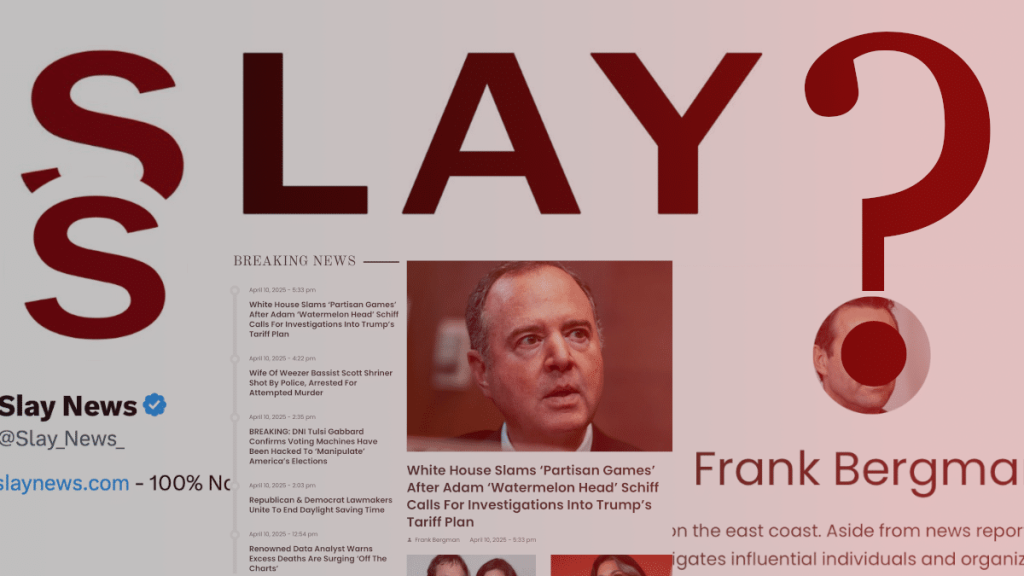Unmasking Slay News: A Deep Dive into a Network of Misinformation
Slay News, a website notorious for disseminating inaccurate and misleading information across various topics, has come under scrutiny following a comprehensive investigation by Science Feedback. While presenting itself as a U.S.-based news outlet, Slay News is registered in the United Kingdom and exhibits connections to One Fox Digital, a UK-based IT consultancy founded by Paul Roughsedge and Stephen Anthony McQueen. One Fox Digital was also behind Neon Nettle, a website previously flagged for publishing false information and conspiracy theories. This revelation raises concerns about the website’s true motives and the potential for coordinated misinformation campaigns.
The investigation delves into Slay News’ content, revealing a pattern of sensationalized headlines and false claims. Examples include articles falsely linking COVID-19 vaccines to increased heart failure rates in Japan and promoting unsubstantiated allegations of election fraud in the U.S. These articles, often written by individuals using likely AI-generated profile pictures, achieve widespread distribution through social media platforms, amplifying the reach of the misinformation. The lack of transparency regarding Slay News’ ownership and funding sources further adds to the suspicion surrounding its operations.
The investigation uncovered a network of interconnected websites linked to Slay News through shared advertising tracking codes. These websites, including evol.news, newsaddicts.com, and newswize.com, exhibit similar content themes and stylistic similarities, suggesting a common operator. This concealed network raises questions about the deliberate obfuscation of ownership and the potential for coordinated dissemination of misleading narratives.
Further investigation of Slay News’ website architecture revealed a hidden email address belonging to Paul Roughsedge, co-founder of One Fox Digital. While Roughsedge denied any involvement with Slay News, claiming his role was limited to website development for One Fox Digital, his social media activities revealed a deeper engagement with Neon Nettle and other related websites. This included promoting Neon Nettle content, addressing fact-check ratings, and resolving social media issues for these platforms. This evidence contradicts Roughsedge’s claim of limited involvement and suggests a more active role in the network’s operations.
The investigation also explored the connection between Slay News and Stephen Anthony McQueen, the other co-founder of One Fox Digital. A Twitter account under the handle @NeonNettle, purportedly belonging to McQueen, explicitly linked Slay News to One Fox Digital, suggesting Slay News was created to circumvent fact-checking efforts targeting Neon Nettle. However, Slay News’ official Twitter account disputed this claim, attributing the @NeonNettle account to a different disinformation source. This conflicting information and the subsequent deletion of the @NeonNettle account further complicate the picture.
The investigation’s findings highlight a concerning trend of coordinated misinformation campaigns operating under a veil of anonymity. Slay News, along with its associated websites, employs tactics such as concealed ownership, AI-generated author profiles, and the repurposing of social media accounts to create an illusion of independent news sources. This network’s focus on U.S. politics, despite its UK origins, raises concerns about foreign influence in online information ecosystems. The investigation serves as a warning to internet users to approach online content with critical thinking and skepticism, especially from sources lacking transparency and exhibiting a pattern of misinformation. The investigation’s detailed analysis and the exposure of these interconnected websites and social media accounts provides valuable insights into the complex landscape of online misinformation and the challenges of combating it.
The Web of Deception: Exploring the Tactics of the Slay News Network
The Science Feedback investigation paints a picture of a sophisticated network designed to spread misinformation while obscuring its true origins. The use of AI-generated author profiles, the concealment of website ownership, and the repurposing of old social media accounts are all tactics aimed at creating an illusion of legitimacy and independence. This sophisticated approach makes it more difficult for users to identify the interconnected nature of these websites and the coordinated nature of their messaging.
The Financial Incentive: Monetizing Misinformation
The presence of advertisements on Slay News and its affiliated websites suggests a financial motivation behind the spread of misinformation. Viral content generates increased web traffic, leading to higher ad revenue for the website operators. This monetization of misinformation creates a perverse incentive to prioritize sensationalized content over factual accuracy, further contributing to the spread of false narratives.
The Challenge of Accountability: Holding Misinformation Networks Responsible
The anonymous nature of these networks makes it difficult to hold those responsible for spreading misinformation accountable. Despite the investigation’s efforts to uncover the individuals behind Slay News, the layers of obfuscation and conflicting information create challenges in establishing clear lines of responsibility. This lack of transparency hinders efforts to combat the spread of misinformation and underscores the need for greater accountability in online information ecosystems.
The Impact of Misinformation: Eroding Trust and Threatening Public Health
The spread of misinformation by networks like Slay News poses a significant threat to public health and erodes trust in legitimate news sources. False claims about vaccines, unfounded allegations of election fraud, and other conspiracy theories can have real-world consequences, influencing public opinion and potentially leading to harmful behavior. Combating this threat requires a multi-faceted approach involving media literacy education, fact-checking initiatives, and platform accountability.
The Future of Misinformation: Adapting to Evolving Tactics
As misinformation tactics become increasingly sophisticated, the need for robust detection and countermeasures grows more urgent. AI-generated content, coordinated disinformation campaigns, and the exploitation of social media algorithms present ongoing challenges. Addressing these challenges requires continuous innovation in fact-checking methods, platform policies, and media literacy education to effectively combat the evolving landscape of online misinformation.
The Call for Transparency: Demanding Accountability from Online Platforms
The Slay News investigation highlights the need for greater transparency and accountability from online platforms. Platforms play a critical role in amplifying the reach of misinformation, and they have a responsibility to implement effective policies to combat the spread of harmful content. This includes investing in fact-checking initiatives, promoting media literacy, and taking action against accounts and websites engaging in coordinated disinformation campaigns.


